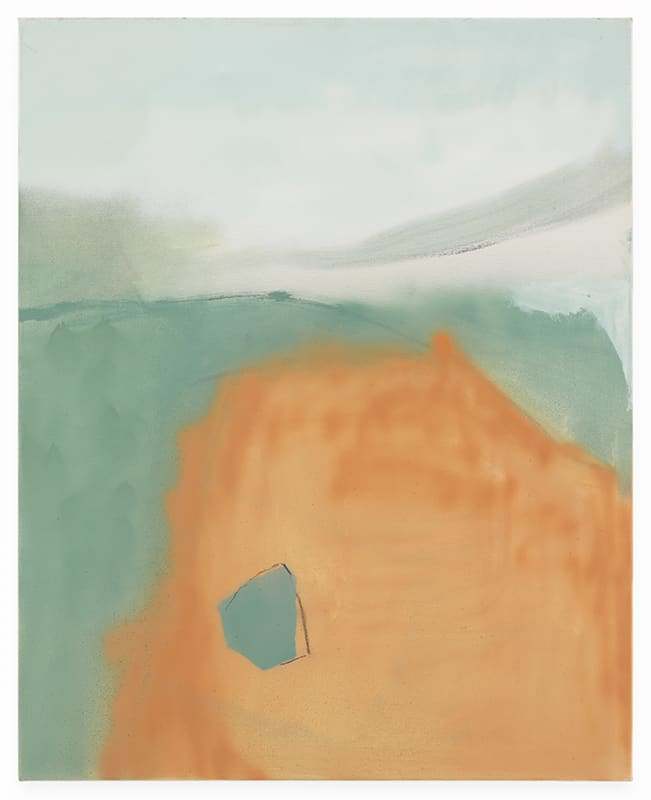-
ESTEBAN VICENTE
SELECTED WORK -
Elaine de Kooning once wrote in ArtNews that Vicente’s work is “caught midway in an attitude of surprise, like [poet] Marianne Moore’s ‘real bird in a painted tree.’” That element of the unexpected, perhaps a vestige of Vicente’s documented anarchist nature from his military upbringing, is as evident here in the late work as it is in the work from the sixties. Electric oranges glow from muted, near-muddy sea of taupe that reads instead as a warm terracotta, as in Untitled (1991). Viridian emerald erupts from an earthy haze in Siva (1960), the color play drawing the eye on a treasure map with pauses in cornflower blues, deep umber and wheat-gold.
-
-
 Siva, 1960Oil on canvas38 x 50 inches
Siva, 1960Oil on canvas38 x 50 inches
Exhibited:
New York, NY: Ameringer & Yohe Fine Art, "Esteban Vicente: The Aristocratic Eye," 15 February - 17 March 2007
Literature:
Sandler, Irving. Esteban Vicente: The Aristocratic Eye, catalogue for the exhibition, New York: Ameringer & Yohe Fine Art, 2007, illustrated in color, p. 25. -
 No. 7, 1961Oil on canvas27 x 36 inches
No. 7, 1961Oil on canvas27 x 36 inches
Exhibited:
Asheville, NC: Asheville Art Museum, "Gestures", 22 October 2021 - 24 January 2022
-
-
Often working from studies in collage, Vicente’s typically vibrant oil paintings reveal an ever-evolving inquiry into abstraction that took place over the course of his life. Vicente maintained a lifelong daily painting practice and always painted in the natural light of his studio. His work was focused around a particular idea about light and space and color which he cultivated early and never abandoned. The New York School veteran fled the Spanish Civil War for New York in 1936 created a vast body of work that is a satisfying amalgam of light and color.
-
The nuances of color are almost always the primary communicators in his work. Inspired by frequent childhood trips to the Prado, Vicente knew from an early age that he’d like to be an artist. He attended the Royal Academy of Fine Arts San Fernando in Madrid in 1921 and his illustrious career lasted over six decades. He lived in Paris, Barcelona, and New York City, but was greatly influenced by the peace of his Bridgehampton farmhouse with his studio in the converted barn and his garden full of colorful flowers. Often described as elegant and mannerly, Vicente was a central member of the Abstract Expressionism’s first generation of artists. Vicente found comradery and friendship in other great painters such as Jackson Pollack and Willem de Kooning and was sometimes spied with them at the legendary Cedar Bar, a Greenwich Village haunt of artists. He was a member of the New York School of painters and is the namesake for PS 107X: The Esteban Vicente Early Childhood School in the Bronx.
-
Esteban Vicente helped organize and participated in the famed 9th Street show, an historic invitational held in Greenwich Village in 1951 that solidified Abstract Expressionism in the U.S. art canon. He was the artist in residence at Princeton University, and the Honolulu Academy of Fine Arts. Over the course of his career, Vicente served on the faculties of many leading universities, including: the University of California, Berkeley, in 1954 and 1958; New York University, 1959–1969; Yale University, 1960–1961; the University of California, Los Angeles, 1962; and Princeton University, 1965–1966 and again 1969–1972. The prize-winning American poet John Ashbery once praised Vicente as being “admired as one of the best teachers of painting in America.” He taught master classes at New York Studio School and Parsons School of Design. In 1991, Vicente received the gold medal in Fine Arts from King Juan Carlos and Queen Sofia of Spain at the Prado Museum. In 2011, the Grey Art Gallery at New York University organized a career retrospective featuring collages, paintings and small-scale assemblages showcasing his talent as both a painter and a sculptor. His work is in major public and private collections around the world, including the Metropolitan Museum of Art, Museum of Modern Art in New York, Tate Modern, and the Reina Sofia in Madrid, to name a few. He died in 2001, leaving us his visual legacy.
SELECTED WORK: ESTEBAN VICENTE
Past viewing_room












